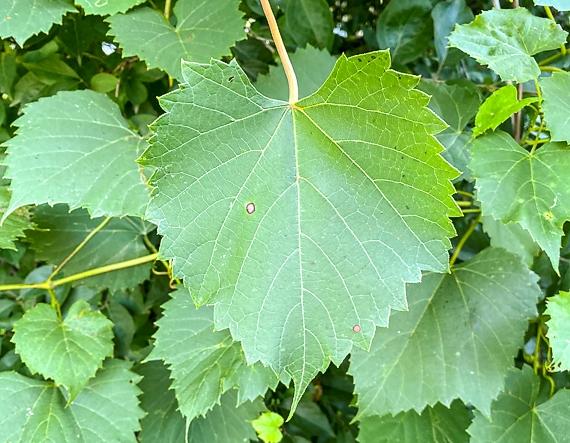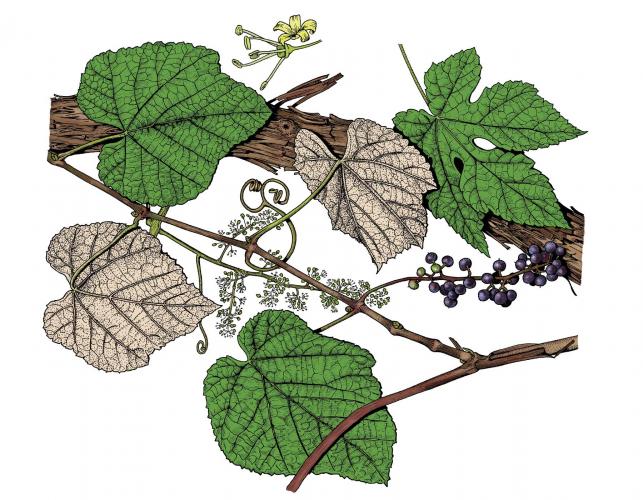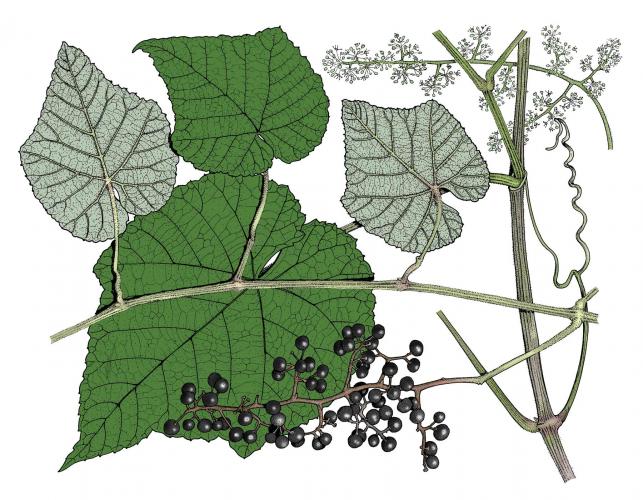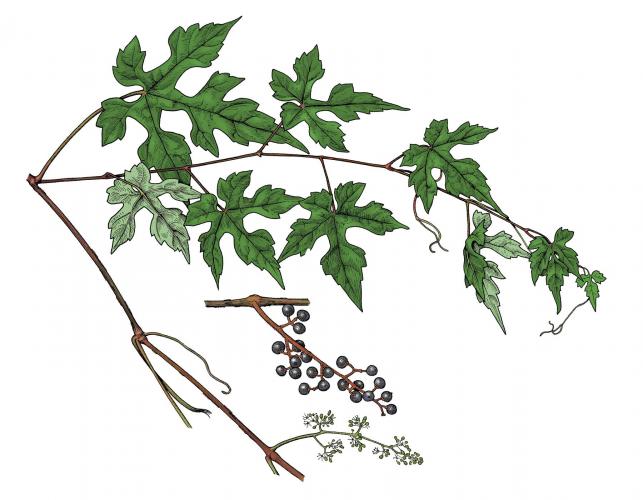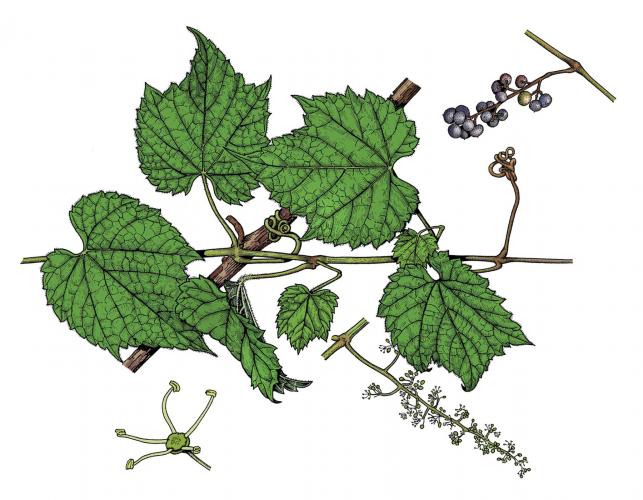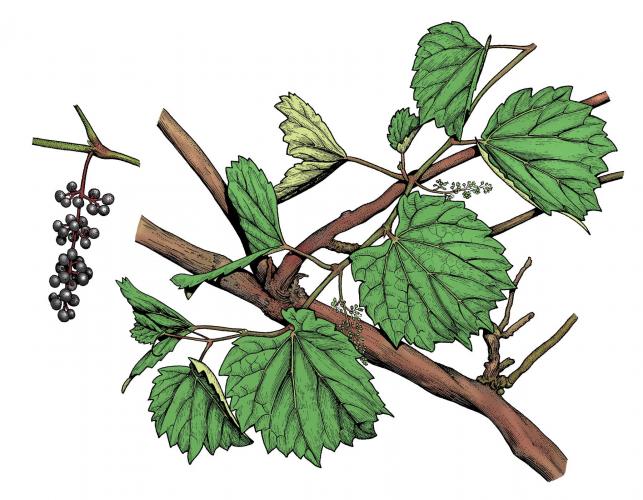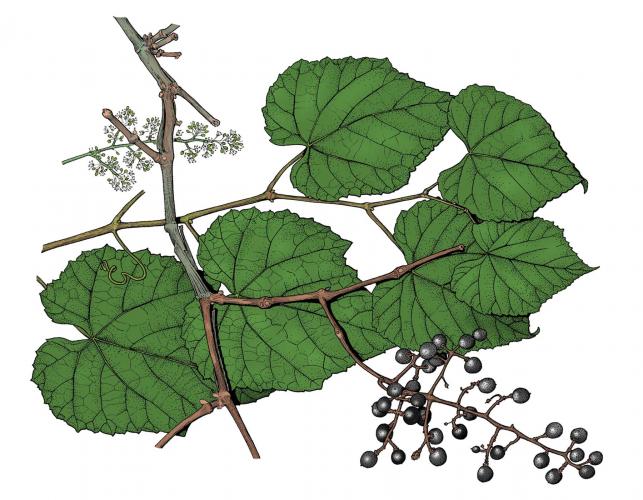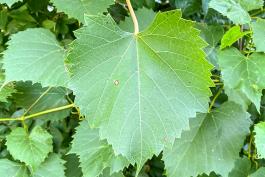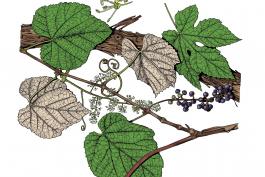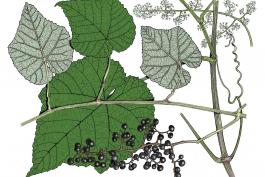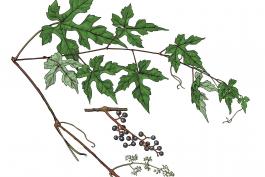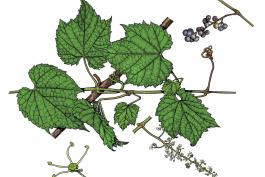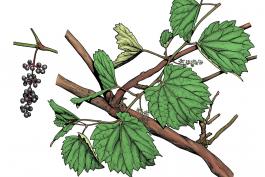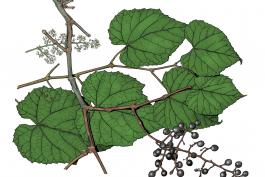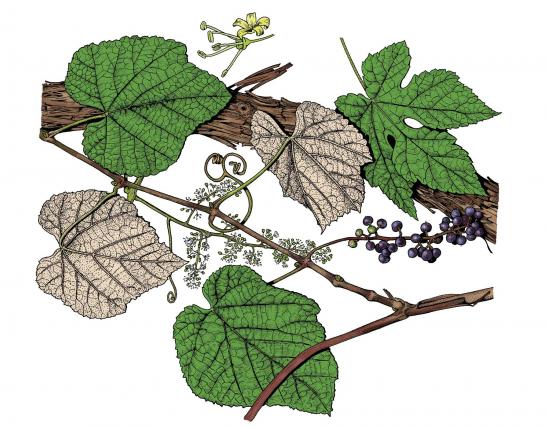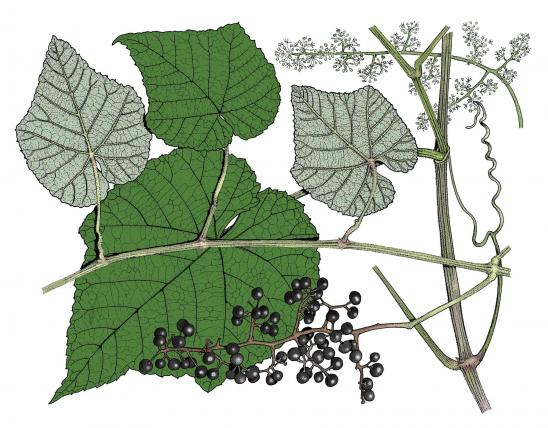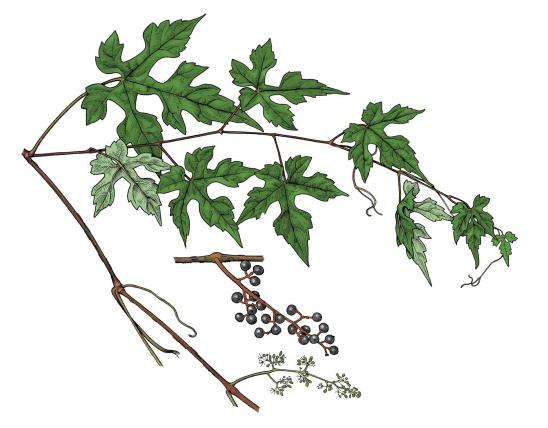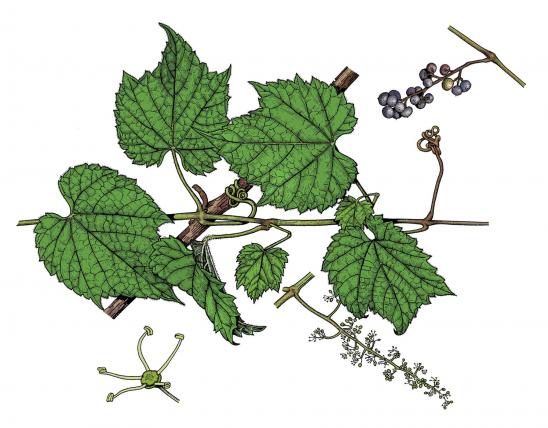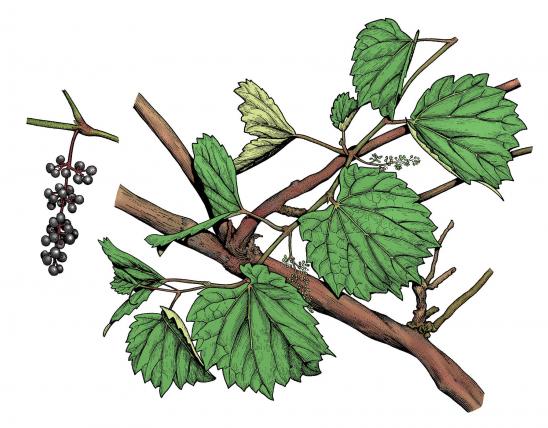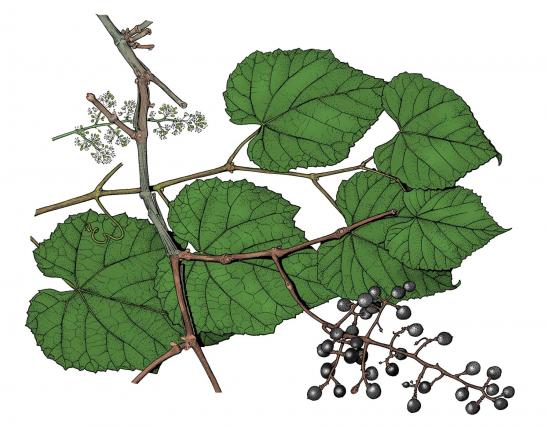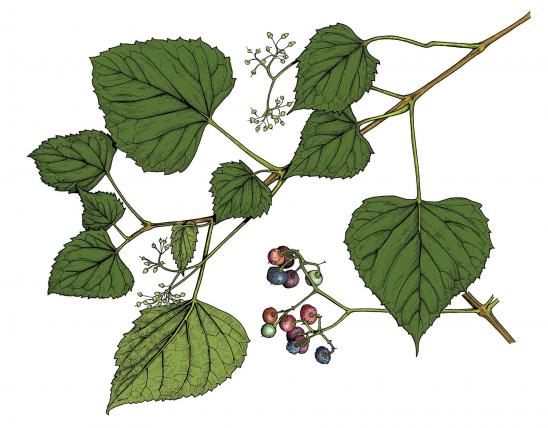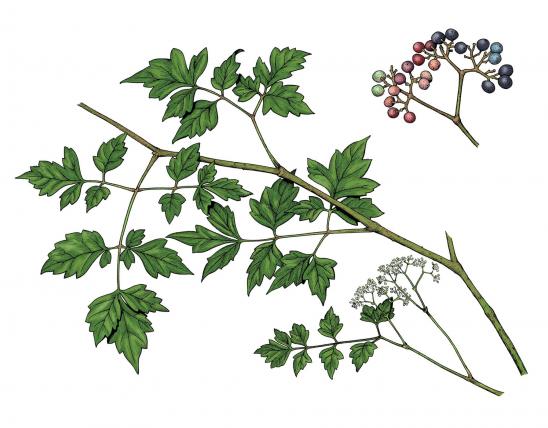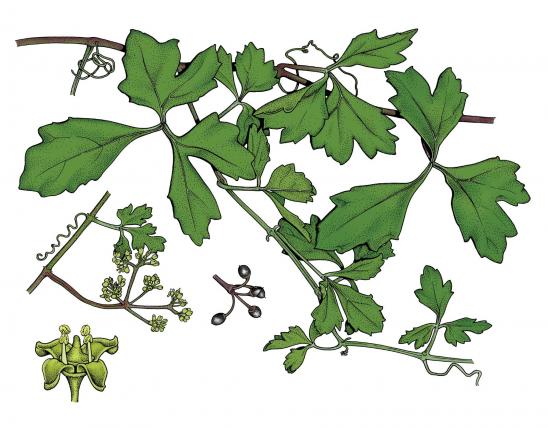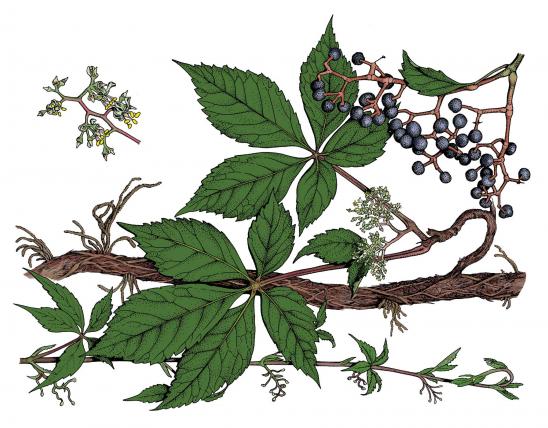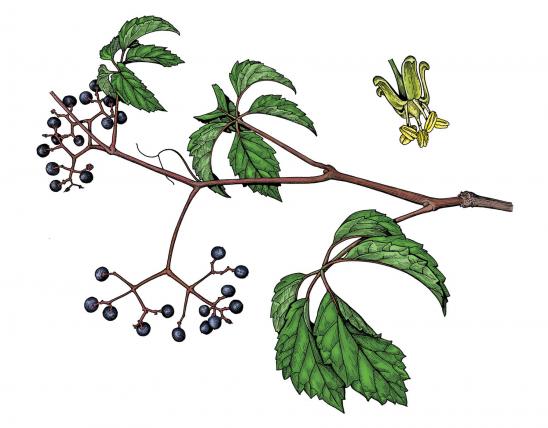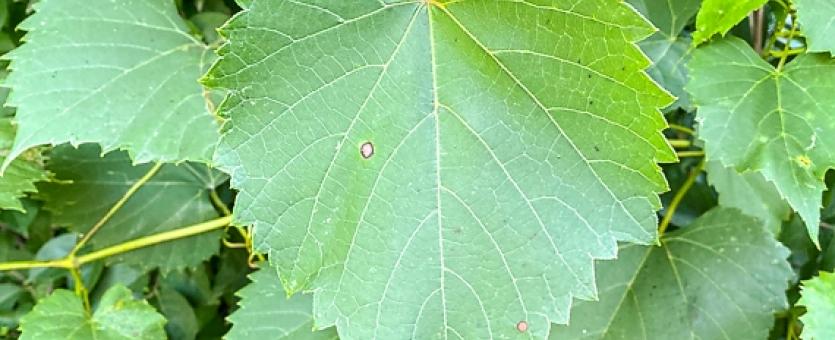
The grape family in Missouri includes 4 genera, including Virginia creeper and woodbine (genus Parthenocissus), marine vine (genus Cissus), and raccoon grape and peppervine (genus Ampelopsis). But the species most people think of as grapes are in genus Vitis — and Missouri has eight of them. Missouri’s members of genus Vitis have several things in common:
Plants are perennial lianas (woody vines) that typically climb into trees, with tendrils (though often lacking in sand grape, V. rupestris); tendrils positioned opposite to leaves and are often branched (except in muscadine, V. rotundifolia). No thorns or spines.
Leaves are simple (not compound), though they may have 3 or 5 lobes that can be shallow or deep. Leaf bases are lobed (leaves are heart-shaped), with a sinus (notch) where the leaf stem meets the blade. Margin with broad, coarse teeth; tip usually pointed.
Stems often swollen at the nodes; pith brown (easiest to see on branches less than ½ inch in diameter) and usually chambered (seen on older branches); bark usually shredding.
Flowers usually greenish yellow, small; male and female flowers in separate clusters on same plant; petals 5. Clusters 3–5 inches long. Petals are fused at the tip and shed as a caplike unit when the flower opens. Flower clusters are longer than wide, and branch more or less pinnately (like a feather, with no branching of branches), sometimes with umbrella-like branching at the final tip of the cluster. Clusters usually opposite the leaves.
Fruits globe-shaped berries, often blue-black, often with a white, waxy coating. Seeds 1–4 per fruit, pear-shaped.
Six Missouri species have their own pages in this guide; links to them are at the bottom of this page:
- Summer grape (V. aestivalis)
- Winter grape (V. cinerea)
- Red grape (V. palmata)
- Riverbank grape (V. riparia)
- Sand grape (V. rupestris)
- Frost grape (V. vulpina)
Also, two more species are found in Missouri. Though uncommon in our state, both are famous for their edible fruits:
- Fox grape (V. labrusca) is native to eastern North America and is introduced, widely scattered, escaping from cultivation, and uncommon in Missouri. It is the species that became the Catawba, Concord, Niagara, and many other cultivars. Its fruit is noted for its strong, earthy “foxy” aroma and for its skins that easily slip off the pulp of mature grapes. Undersides of young leaves are densely covered with long cobwebby hairs, and tendrils and/or flower stalks are present in at least some groups of 3 or more adjacent nodes.
- Muscadine (V. rotundifolia), also called scuppernong and southern fox grape, is uncommon and known only from one Bootheel county (Dunklin). It is the ancestor of the cultivated muscadine grapes used as table grapes, raisins, jelly, and wine. It is unusual for the genus, as its bark remains tight on older stems (it doesn’t shred) and appears irregularly warty. Also, the pith continues through the nodes, and its tendrils do not branch. Some botanists give it its own genus, Muscadinia.
The stems of most of our native grapevines can reach 65 feet or more in length.
Various species are distributed statewide, though they are least widespread in the glaciated plains in northern Missouri.
Habitat and Conservation
Most Missouri native grape species prefer lowlands and bottomlands, riversides, bases of bluffs, or other low, moist, or wet areas, where they climb into trees. Summer grape is notable for preferring relatively drier, upland situations. A few species are especially associated with streambank communities.
Status
Globally, there are about 65 species in genus Vitis. Eight are native or naturalized in Missouri.
Human Connections
All of Missouri’s wild grapes (genus Vitis) reportedly make a decent grape jelly; look online for recipe ideas for jelly, pies, juice, sherbet, and wine. The young, tender leaves are a nice (though chewy) addition to a tossed salad, and they can impart a great flavor to a dill crock, if you add a few grape leaves and young tendrils between layers of the vegetables to be pickled. You can stuff grape leaves with a precooked, seasoned rice, herbs, and meat mixture; called dolmas, this is an ancient Mediterranean cooking technique.
If you harvest wild grapes for eating, make sure not to confuse them with the poisonous moonseed, whose leaves and fruits look similar to those of grapes. Moonseed’s flattened, crescent-shaped “moon” seeds within the berries are a key identifier; also, moonseed’s vines do not have shredded bark like most grapes, and its leaves, though lobed, are not toothed.
Grapes have an extremely long history with humanity, dating to the dawn of agriculture. Before people understood how yeast and fermentation works, the transformation from juice into wine seemed miraculous. Since antiquity, many cultures have used wine in religious rituals. Many spiritual traditions have included deities associated with grapes and wine, notably the Greek Dionysus and Roman Bacchus, but also goddesses and gods from Sumer, Egypt, and China. Wine plays a central role in several biblical narratives and for most Christians is an important part of the Eucharist.
Globally, grapes are a lucrative commercial fruit crop, made into juice, jellies, jams; dried for raisins; and fermented into wine and further processed into beverages such as champagne, sherry, and cognac.
Extracts from grape skins are used as colorants for other foods and beverages, and refined grape juice is used as a natural sweetener in a variety of foods.
Missouri’s wine industry began with an influx of European immigrants in the early 1800s and grew tremendously; by the 1880s, the state was producing 2 million gallons of wine a year. In the 1920s, Prohibition caused the industry’s collapse. Reborn in the 1960s, the state’s wine industry has again flourished, with more than 125 wineries in the state contributing to a $1.76 billion industry.
Summer grape, V. aestivalis, in its Norton/Cynthiana hybrid-cultivated form, is the official grape of Missouri. Complex, dry, red Norton varietals form the centerpiece of many Missouri wineries.
When they were imported to France in the 1850s, American grape vines carried with them the phylloxera root louse, a tiny aphidlike pest endemic to the New World. Old World grapes had no resistance to this North American insect, and almost immediately, a third of French vineyards were destroyed. The louse spread invasively to all the grape-growing regions of Europe. Missourians Charles Riley, Hermann Jaeger, and George Hussman (“the father of the Missouri grape industry”) were key figures in the discovery that rescued the European wine industry. The solution was to graft the European grape varieties onto naturally resistant American rootstocks, enabling the precious European grapes to survive. Missouri and Texas supplied most of the rootstocks that saved the European wine industry. Missouri’s riverbank, sand, and summer grapes were some of the key species for this effort. Missouri’s grafted grapes were also imported to California to improve the wine industry there, as well.
Ecosystem Connections
Sweet, juicy grapes are relished by many species of birds and mammals. Several mammals eat the leaves, stems, and tendrils as well.
Insects eat the leaves, including the larvae of some species of sphinx moths, which require grape-family plants as a food source. Japanese beetles have a particular fondness for grape leaves, and large infestations leave behind skeletonized remnants of the leaves’ vascular system.
Lowland and riverside vines play an important role in bank stabilization, helping to prevent floodwaters from washing away soil.
Where they form thickets, grapes and other woody vines create good habitat for birds to nest in and for mammals to hide.
Several bird species use the shreddy bark of grapevines as nesting material.
Grapevines sometimes harm the plants they climb on, as they compete for sunlight and grow increasingly heavy.
